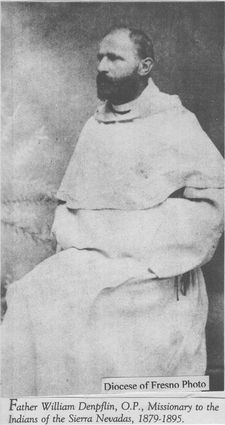In the Beginning....
The Spirit of Tehachapi
Tehachapi was once a vast, spacious valley with tall waving grasses, ample wild game and running streams. Magnificent oaks grew in profusion along with pine and fir. With the Tehachapi Mountains to the south and the tip end of the great Sierra Nevada Range to the north, the valley in between was blessed with pleasant summers and enough rain and snowfall to grow any food needed.
Although the vast Mojave Desert was located just over the Tehachapi Range, it didn't seem to intrude upon the ideal home of the valley's first residents.
The first local people – the Kawaiisu, or the Nϋwa (The People) as they called themselves – were peaceful, Native Americans who welcomed the first explorers passing through their land. In 1776 Father Francisco Garces was greeted kindly by these people as was Kit Carson, Jedidiah Smith and John C. Fremont in the early 1800s.
Later in 1879, Father William Denpflin, a Catholic Priest of the Dominican Order, began yearly trips through the valley. He ministered to the Indians of the Sierra Nevada range and established such an orderly routine for his visits that the Kawaiisu were able to send scouts ahead to announce his coming so they could have rude brush chapels (called Kahnis) already built in which he could celebrate Mass.
They were somewhat in awe of him because of his large stature, thick red beard and white robes. They called him Padre Blanco and were the first, but not the last residents of the Tehachapi area to be kind to visitors coming to their valley.
Padre Blanco was called to Rome in 1896 and was next heard of in the mission fields of Guatemala. Years later, old, thin and weather beaten, he died in a New York hospital. His last request echoed his love of the California Native Americans who had befriended him, when he asked for an Indian blanket to be put around his shoulders.
As the population of the valley began to include its first settlers, the residents tried out a few names before making a final decision for their community. Old Town was once Williamsburg, but ended up being called Tehichipa. Then the railroad came through and many of the Old Town families moved to the newly founded town site. Some also moved their houses on log rollers. Early day mobile homes! They experimented with the name Summit for a while, but it didn't stick. The town's name moved right with them, and it became Tehachapi – which is the spelling the Southern Pacific Railroad settled upon. Old Town lost its name and may have been called Old Tehachapi at one time and just evolved into simply, Old Town. No facts were ever recorded as to the actual details. They were busy making history, not recording it. Another little community – Greenwich, founded by P.D. Greene – was located northwest of our present site in a lovely grove of oaks and nearby water. It was a thriving little community that disappeared into history after the advent of the railroad.
It is interesting to note the many different spellings of an already hard to spell name. In that period of time many versions were used such as Tehecita, Tehichipa, Tah-ee-chay-pah and others. One must remember that during the mid-nineteenth century literacy was something that every citizen did not possess. The process of "moving west" sometimes left education behind for a time.
Some folk could not read and write at all and those that could were often not as learned as they would have liked people to believe. This could possibly account for the varied versions that prevailed for a time. As aforementioned, the Southern Pacific Railroad finalized it and, right or wrong can be responsible for the current spelling: Tehachapi.
Even the meaning of the word seems to vary with the person telling the story. When it's in print, people are likely to think it is authentic, but that really is not always the case. Sometimes local interpretations creep into what is thought to be actual lore, and – as a result – many variations evolve.
"Plenty of water and acorns," "windy place," "high eagle's nest," "crow's nest" and "flat place covered with oaks," could all be valid as far as description goes. It is documented, however, that the Kawaiisu word "Tiha-cipi-a" means "hard climb," so it must also be included on the list. I used to favor the one about the high eagle's nest, but in later years I have come to the conclusion that the Kawaiisu definition should be the one that should prevail. After all, they were here first!
The cordial greeting of the Kawaiisu seems to have stayed in our valley throughout the years. When meeting someone on our local streets I feel the need to say hello, whether I know them or not. One day, when I did that, I was asked by a lady, "Am I supposed to know you?" I assured her that we were not acquaintances; the meeting was just a friendly hello. Often, I think the same thing when greeted by someone by thinking, "Now, who in the heck was that?"
As a child, I was spoken to when meeting an adult on the street, who would ask how I was, how was my Mama and to be sure and tell her hello. At any rate, it seems that the old Kawaiisu habit of a friendly greeting has not disappeared, for most of our citizenry do extend a friendly hello. To greet you as our first Kawaiisu people might have, I will say, "Hagare 'enaan?" I just asked you how you were!





